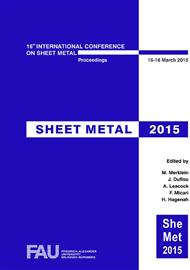p.147
p.155
p.163
p.173
p.179
p.187
p.195
p.205
p.213
Accuracy and Material Properties in Incremental Forming for a Multi-Step Expanding Approach
Abstract:
In incremental sheet forming the material properties change dependent on the wall angle. In addition to sheet thinning, material hardening can be observed and for stainless steel the formation of strain induced martensite has been reported. These process characteristics have been extensively examined for the forming of parts in one step. In this study, a first investigation is made to control the material properties independent on the wall angle by a multi-step expanding approach. For this, in the first step a steep wall angle is formed and in the following steps this region is transformed to a shallow wall angle, keeping the material properties. To demonstrate and verify this new approach a small cone frustum with a wall angle of 60° was formed as a preform. This cone frustum was repeatedly expanded in steps of 2° to get finally a cone frustum with 30° wall angle. The stepwise expanding causes a considerably growing of the shape in depth direction, especially at the preformed area. By a heuristic approach the geometric accuracy of the final cone was optimized. The microhardness measurement of the formed cones shows that the final cone frustum has a region, where the material properties are similar to the first formed 60° wall angle. By this new approach the possibility to influence the material properties of the final part purely by tool path is demonstrated. In particular it is possible to form regions with shallow wall angles that have the material properties of regions with steep wall angles.
Info:
Periodical:
Pages:
179-186
Citation:
Online since:
March 2015
Authors:
Keywords:
Price:
Сopyright:
© 2015 Trans Tech Publications Ltd. All Rights Reserved
Share:
Citation:


